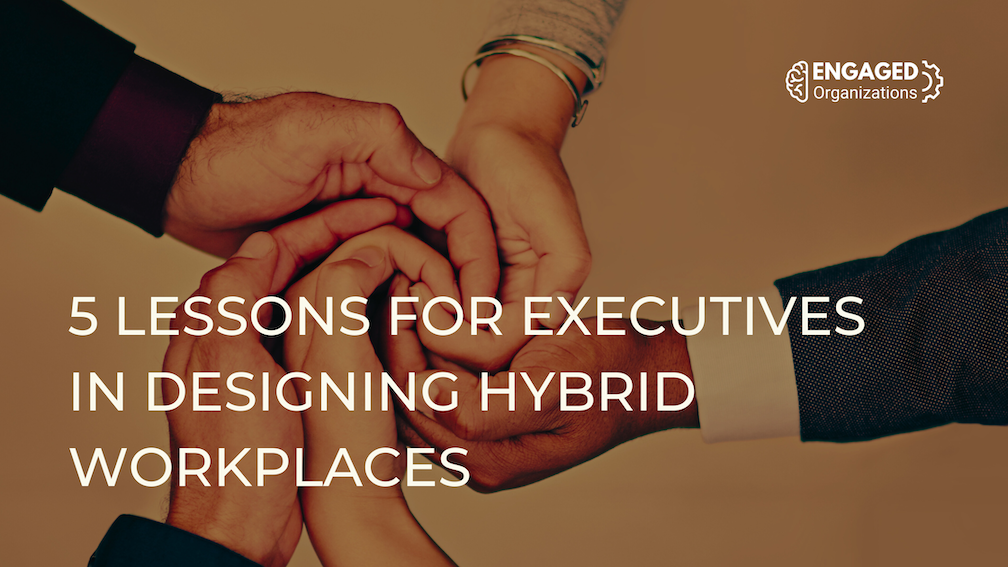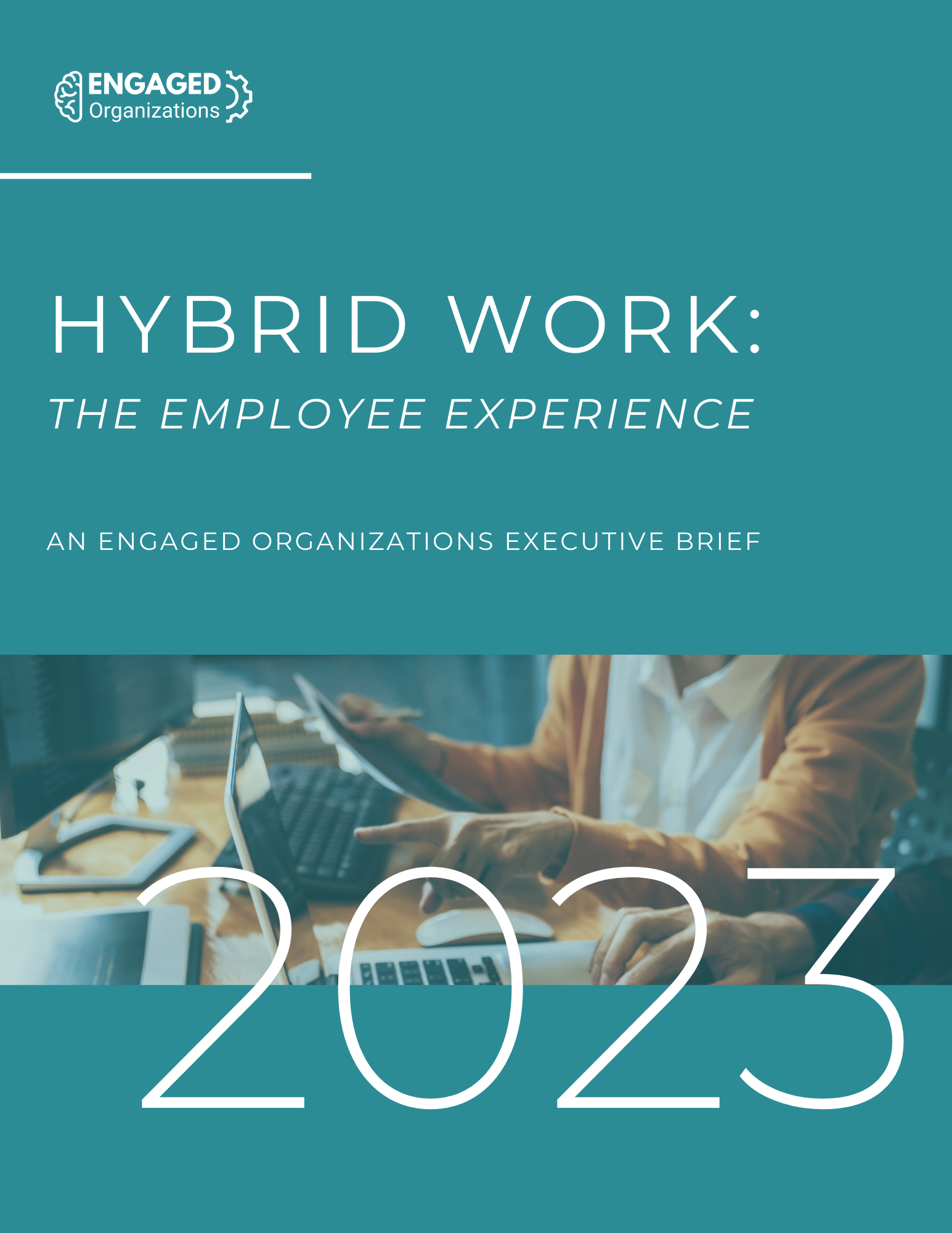We gathered 20 digital and collaborative workplace strategists to discuss the findings and recommendations included in our Hybrid Work Executive Brief. We also wanted to hear their perspectives and experiences on solutions that increase the effectiveness of hybrid work. These experts included individuals across sectors and in different roles and resulted in a rich and energizing conversation as well as a broad perspective on the challenges, opportunities, and solutions related to hybrid work environments.
To Change Workplaces, Leaders Must Change
During our conversation, a few resonant truths emerged. The first of which is that communications and collaboration platforms create network effects. So much unnecessary work is created by the overlapping network effects of multiple platforms and channels as well as a lack of shared agreement on how and where to work. The second is that executives expect employees to help foster connections with personal discretionary effort or change work habits to incorporate more asynchronous communication, while executives themselves don’t model either, undermining its success.
Five Recommendations from Workplace Strategists
Employees do experience online fatigue and crave in-person connection but resent performative requests, which waste their time. Employees also want the schedule control and flexibility that hybrid work provides. Understanding the root causes of both risks and the potential of hybrid work is critical for executives and what they will find is that the risks and potential lies not in WHERE work is done but in HOW work is done.
From the assembled digital workplace experts, these five recommendations for executives emerged:
- ACKNOWLEDGE the DISCRETIONARY EFFORT required to foster workplace connection and cohesion in offices, placed largely on women when it goes unacknowledged. Invest in roles responsible for this work in both offices and in digital spaces.
- ALIGN WITH EMPLOYEES ON WORKPLACE CHALLENGES before suggesting or creating solutions based on personal experience and needs.
- DESIGN OFFICES AS PLATFORMS for group connection, engagement, conversation, and shared experiences.
- INVEST in COLLABORATIVE TEAM COMMITMENT PROCESSES with updated tools and leadership training.
- DEMONSTRATE BEING APPROACHABLE, AUTHENTIC, and TRANSPARENT about decisions and challenges, across channels and groups.
Like all digital engagement and channels, hybrid work exposes and accelerates the impact of old gaps and flaws. For decades, CEOs and boards have avoided confronting the issues created by accelerating technology and the chaos of overlapping digital channels by surrounding themselves with staff who could maximize in-person engagement and protected them from the noise. The pandemic likely disoriented many of those executives, who had no experience with or habit of connecting casually online or being accessible to thousands of people.
The benefits for senior executives of communicating transparently and engaging with networks of diverse people and perspectives are many but chief among them is that they are more approachable.
Executive approachability results in hearing and knowing more about what is going on, engendering more employee trust, and powerfully demonstrating to employees how to engage online and that it is OK to do so.
The Flex Index Q4 2023 report stated, “The average public company that gives employees choice over whether to come into an office also outperformed on revenue growth over the past three years by 16 percentage points, compared to companies with more restrictive policies.”
In our survey, we found that top-ranked benefits of employees included both schedule control and flexibility for themselves and productivity, which benefits their organization. People want to work, but they also value self-determination. It is a powerful example of the shared value generated by a collaborative strategy, even if that collaborative strategy was unintentional.
Who Makes Decisions About Hybrid Work?
If your organization is already a hybrid workplace, there are likely a lot of people involved. Adapting to a hybrid workplace has implications for strategy, operations, and tactics. Most organizations are muddling through. We wanted our group of workplace strategists and experts to weigh in so we asked them who they thought should be the lead on decisions in each of these areas.
For strategic decisions related to hybrid work, there was a decidedly mix of responses and while CEO and Leaders were the most common answers, we also got an employee experience center of excellence, business development and strategy team, the whole organization, and managers and depending on the scope of the strategy, those all might be good options.
For operational decisions, answers included COO, cross-functional core team, executive leadership team, shared services organization, and managers.
For tactical decisions, almost all the answers were either employees themselves or line/people managers.
Final Thoughts on Designing Hybrid Workplaces
Every organization is now a hybrid workplace – even those that do not acknowledge it. Employees have been traveling for work, working at home with sick kids, and using technology to interact with colleagues sitting across offices for decades. Early in my career, at a large management consulting firm, I was working via dial-up and using text chat daily in the 1990s – and feeling the implications when a partner would ping me on chat at 10 pm. I was also using a very early version of video meetings. This digital workplace technology has been around a long time.
What’s different is that all knowledge workers have realized that they no longer need to sacrifice hours of unpaid time to daily commutes and that work can be just as effective – if not even more productive – when they work remotely. Hybrid work makes employees’ lives so much more flexible in ways that reduce stress. That is something everyone should celebrate, regardless of the sunk cost in real estate investments.
The challenge now is one of workplace design. How do we adapt organizations and reckon with all the new technology and information so that work is effective and long-term career success is not hampered by physical differences? The biggest barrier to progress is not about the information and systems, however, but about power, organizational politics, and designing governance that distributes power and control while increasing transparency so that it reduces division. It is a collaborative social system design that requires a holistic assessment of how the system works today and rethinking how it will work tomorrow.





